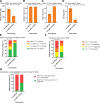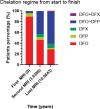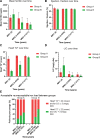Successful chelation in beta-thalassemia major in the 21st century
- PMID: 37832083
- PMCID: PMC10578721
- DOI: 10.1097/MD.0000000000035455
Successful chelation in beta-thalassemia major in the 21st century
Abstract
This century has seen a revolution the management of beta-thalassemia major. Over a 12-year period to 2016, we aimed to analyze the benefits of such advances. In 209 patients, independent of the chelation regimen, ferritin, cardiac T2* and liver iron concentration changes were evaluated. We defined chelation success (ChS) as no iron load in the heart and acceptable levels in the liver. Over 3 early magnetic resonance imagings, the same parameters were assessed in 2 subgroups, the only 2 that had sufficient patients continuing on 1 regimen and for a significant period of time, 1 on deferrioxamine (low iron load patients n = 41, Group A) and 1 on deferoxamine-deferiprone (iron overloaded n = 60, Group B). Finally, 28 deaths and causes were compared to those of an earlier period. The 209 patients significantly optimized those indices, while the number of patients with chelation success, increased from 6% to 51% (P < .0001). In group A, ChS after about 8 years increased from 21 to 46% (P = .006), while in Group B, from 0% to 60% (P < .001) after about 7 years. Deaths over the 2 periods showed significant reduction. Combined clearance of cardiac and liver iron (ChS) is feasible and should become the new target for all patients. This requires, serial magnetic resonance imagings and often prolonged intensified chelation for patients.
Copyright © 2023 the Author(s). Published by Wolters Kluwer Health, Inc.
Conflict of interest statement
Vasili Berdoukas is a paid consultant to Chiesi Canada Inc. Chiesi is the distributor of the iron chelator deferiprone. The other authors have no conflict of interest to disclose.
Figures




References
-
- Anderson LJ, Holden S, Davis B, et al. . Cardiovascular T2-star (T2*) magnetic resonance for the early diagnosis of myocardial iron overload. Eur Heart J. 2001;22:2171–9. - PubMed
-
- Cappellini MD, Piga A. Current status in iron chelation in hemoglobinopathies. Curr Mol Med. 2008;8:663–74. - PubMed
-
- Tanner MA, Galanello R, Dessi C, et al. . A randomized, placebo-controlled, double-blind trial of the effect of combined therapy with deferoxamine and deferiprone on myocardial iron in thalassemia major using cardiovascular magnetic resonance. Circulation. 2007;115:1876–84. - PubMed
-
- Farmaki K, Tzoumari I, Pappa C, et al. . Normalisation of total body iron load with very intensive combined chelation reverses cardiac and endocrine complications of thalassaemia major. Br J Haematol. 2010;148:466–75. - PubMed
MeSH terms
Substances
LinkOut - more resources
Full Text Sources

